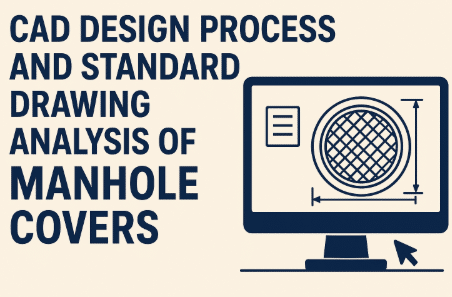In modern infrastructure, manhole cover customization plays an essential role in ensuring urban safety, durability, and efficiency. What was once a simple cast iron component has now become a highly engineered product, designed through advanced digital tools and manufactured according to rigorous international standards. This article explores the CAD design process and the analysis of standard drawings in manhole cover projects, providing insights into how precision, compliance, and customization come together to deliver reliable urban solutions.
Why CAD Design Matters in Manhole Cover Customization
With the growing complexity of cities, the demand for customized infrastructure solutions is higher than ever. Manhole cover customization enables engineers to create covers that meet specific requirements related to load-bearing capacity, corrosion resistance, and aesthetic integration.
The use of CAD (Computer-Aided Design) software in manhole cover design brings multiple advantages:
- Precision engineering: CAD allows highly detailed 2D and 3D representations of manhole covers.
- Load simulations: Engineers can test durability against heavy traffic or industrial conditions.
- Custom flexibility: It becomes easier to adapt shapes, patterns, and materials.
- Error reduction: Digital models minimize design mistakes during manhole cover manufacturing.
The Step-by-Step CAD Design Process for Manhole Covers
1. Defining Project Requirements
The process begins with identifying project needs: expected load categories (light, medium, or heavy traffic), site environment (residential streets, highways, or airports), and compliance with manhole cover standards such as EN 124 or ASTM.
2. Conceptual Drafting
Engineers prepare initial sketches to outline dimensions, locking systems, surface textures, and ventilation holes if required.
3. 3D Modeling with CAD Tools
Using CAD software, a detailed manhole cover design is created. This includes thickness, frame alignment, and reinforcement patterns. The 3D model provides a realistic preview of the final cover.
4. Structural Simulation
At this stage, finite element analysis (FEA) is conducted to simulate stress, load distribution, and durability. This ensures that the manhole cover can meet its designated performance class before manufacturing.
5. Drafting Standard Technical Drawings
The 3D model is converted into standard drawings containing dimensions, tolerances, cross-sections, and technical notes. These drawings serve as the master reference for manhole cover manufacturing.
Manhole Cover Standards: Ensuring Safety and Quality
Compliance with international manhole cover standards ensures safety, durability, and regulatory approval. Some of the most recognized standards include:
- EN 124 (European Standard): Defines classes A15 to F900, covering pedestrian walkways to heavy-duty industrial use.
- ASTM Standards (U.S.): Focus on materials, testing, and manufacturing methods.
- ISO Standards: Ensure consistency in quality control and production processes worldwide.
By following these standards, manufacturers guarantee that customized manhole covers perform reliably under real-world conditions.
Analysis of Standard Drawings in Manhole Cover Design
Standard drawings are not just technical illustrations—they are the foundation of successful manhole cover customization. They typically include:
- Top view with patterns and dimensions (for anti-slip and branding).
- Cross-sectional drawings (showing thickness and reinforcement).
- Tolerance specifications (ensuring manufacturing accuracy).
- Assembly diagrams (explaining installation methods).
Accurate drawings help reduce errors during manhole cover manufacturing and improve communication between engineers, suppliers, and construction teams.
Role of Manhole Cover Customization in Modern Infrastructure
Urban Safety
Customized covers prevent accidents by ensuring load capacity matches site conditions.
Aesthetic Integration
Covers can be designed with logos, city emblems, or decorative patterns.
Environmental Considerations
Advanced manhole cover design includes the use of eco-friendly composite materials, which reduce carbon footprint compared to traditional cast iron.
Cost Optimization
While customization may increase design time, it reduces long-term maintenance and replacement costs.
Manhole Cover Manufacturing: From Design to Production
The transition from design to production involves several steps:
- Material selection: Cast iron, ductile iron, or composite materials.
- Pattern making: Creating molds based on CAD designs.
- Casting or fabrication: Depending on material choice.
- Finishing: Machining, coating, and surface treatments.
- Quality testing: Verifying compliance with manhole cover standards.
This process ensures that each customized cover meets structural and regulatory requirements.
Internal Linking Suggestions
When publishing this article on a company website, you can add internal links such as:
- “Manhole Cover Manufacturing Process” → Detailed guide on casting and finishing techniques.
- “Comparison of Composite and Cast Iron Manhole Covers” → Related product insights.
- “Applications of Customized Manhole Covers in Urban Infrastructure” → Case studies.
These internal links help strengthen topical authority and improve Google SEO rankings.
Conclusion
The CAD design process and analysis of standard drawings are crucial for producing reliable, safe, and aesthetically pleasing manhole covers. Through manhole cover customization, municipalities and construction companies can ensure that each cover not only complies with international manhole cover standards but also meets the unique requirements of modern infrastructure.
FAQ
1. Why is CAD important in manhole cover customization?
CAD ensures precision, allows structural testing, and supports efficient communication between designers and manufacturers.
2. What standards should manhole covers comply with?
EN 124, ASTM, and ISO are the most widely recognized standards worldwide.
3. How does customization benefit urban projects?
It improves safety, aesthetics, durability, and reduces long-term costs.
4. What materials are commonly used in manhole cover manufacturing?
Ductile iron, cast iron, and composite materials are the most common options.
5. Can manhole covers be designed with city logos?
Yes, customized covers often feature logos, patterns, or emblems to enhance city branding.





